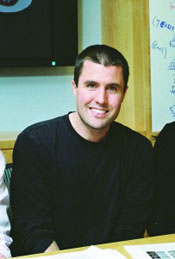Pop! A mammary epithelial cell detaches from the extracellular matrix, the collagenous material that binds the cells of tissues together. Such outcasts usually die quickly, but not this one. Instead, the vagabond burrows into a healthy cell, a phenomenon called entosis. Most entosed cells soon die—but again, not this one. Instead, this cell squats in a vacuole until the time comes for its host to divide. What happens next researchers are only beginning to understand, and their discoveries are shedding new light on aggressive cancers.
 Entosis, the process by which wandering cells invade host cells to form cell-in-cell structures, was first described in 2007 by a team led by Joan Brugge, chair of Cell Biology at HMS, and former research fellow Michael Overholtzer, now at Memorial Sloan-Kettering Cancer Center. While this process generally contributes to tumor suppression by eliminating rogue cancer cells, this spring, the group reported a new role for entosis: Entosed cells arrest host cells midway during cell division and generate abnormal chromosome content, a condition called aneuploidy that is a marker of aggression in human cancers.
Entosis, the process by which wandering cells invade host cells to form cell-in-cell structures, was first described in 2007 by a team led by Joan Brugge, chair of Cell Biology at HMS, and former research fellow Michael Overholtzer, now at Memorial Sloan-Kettering Cancer Center. While this process generally contributes to tumor suppression by eliminating rogue cancer cells, this spring, the group reported a new role for entosis: Entosed cells arrest host cells midway during cell division and generate abnormal chromosome content, a condition called aneuploidy that is a marker of aggression in human cancers.
Cancer metastasizes when tumor cells break free from their primary location, invade local tissue, spread through the lymph or blood, and set up homesteads in distant tissues. Since most cells depend on signals from the extracellular matrix within their normal niches, normal cells are unable to survive floating free in the bloodstream. The same is true for cancer cells during metastasis.
While studying how detached mammary epithelial cells undergo cell death in the Brugge lab, Overholtzer stumbled on the phenomenon of entosis, observing that many detached cells actively invade other cells and take refuge in vacuolar structures within their host cells. He also discovered that the fate of most internalized cells was death following entosis, which he distinguished from genetically programmed cell death, or apoptosis. To survive metastasis, a tumor cell must avoid nutrient deprivation and metabolic impairment due to loss of signals in their normal niches, as well as death by apoptosis or entosis.
Although biologists had reported cell-in-cell structures as far back as 1864, Brugge credits Overholtzer’s “keen observational skills” and curiosity for several new discoveries: that matrix-detached cells burrow into host cells; that there is a new, lysosomal death program mediated by entosis; and that cell-in-cell structures formed fortuitously bear significant physiological consequences.
Red Flag For AggressionObserving that entosis occurs in human tumors in vivo and that most entosed cells were killed inside their hosts, Brugge and Overholzer proposed in 2007 that entosis suppressed tumors by eliminating wandering tumor cells. But their latest findings, published in the March 2011 issue of Nature Cell Biology, point to another, more sinister, role.

In considering the potential effects of entosis on host cells, the researchers made an unexpected discovery: Under certain conditions, entosed cells halted cell division, leaving their hosts aneuploid—stuck with an abnormal number of chromosomes.
After duplicating its chromosomes through mitosis, a cell cleaves into two daughter cells. Using time-lapse microscopy in the Brugge lab, Overholtzer observed that some entosed cells, upon failing to divide properly, became binucleate. Following up on these observations, Matej Krajcovic, the lead author of the study from the Overholtzer lab, found that entosed cells physically blocked the plane of cell division, and that the resulting binucleate host cells generated highly aneuploid cell lineages. Some entosed cells caused even more havoc, disrupting two cycles of host-cell division and creating “Frankenstein” cells marked by additional chromosomal errors. The researchers concluded that entosis-driven aneuploidy could be tumor-promoting and might serve as a marker for certain cancers with high levels of genomic instability.
Together, the two papers on entosis make a testable prediction, Overholtzer said. A tumor-cell population undergoing entosis at high rates would expand or grow slowly due to the constant death of some tumor cells; but in the long run, any remaining host cells would be endowed with aggressive characteristics due to aneuploidy, a known promoter of tumor progression.
“So the same process that could slow tumor growth might also contribute to promoting chromosomal changes ultimately associated with more aggressive cancers,” Overholtzer said.
These findings have profound implications for aggressive human cancers, including breast cancers, in which the frequency of cell-in-cell structures correlates with disease severity. Because cell-in-cell structures are often reported in tumor cells extracted from fluid in the abdomen or lungs, the researchers hope to understand how and whether entosis in matrix-detached breast-tumor cells might exacerbate secondary cancers in the lungs.
Entosis research is a field in its infancy and a rich vein for inquiry, Brugge said. Molecular mechanisms behind the formation of cell-in-cell structures and the elimination of entosed cells remain poorly defined. Overholtzer’s lab is now investigating what lets loose the lysosomal death pathway on an unsuspecting entosed cell, knowledge that could one day be used to kill tumor cells.
While chance may favor the prepared research fellow, landmark discoveries require concerted cooperation between a curious postdoc willing to explore uncharted territory and an adviser open to risk-taking. “I give Mike a lot of credit,” Brugge said, “and he thanks me for allowing him to do it.”
For more information, students may contact Michael Overholtzer at overhom1@mskcc.org.


